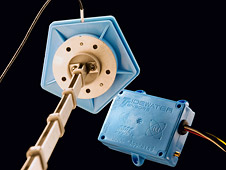 Boat owners now have a better idea of the amount and purity of their fuel thanks to a NASA-developed wireless sensor technology.
Boat owners now have a better idea of the amount and purity of their fuel thanks to a NASA-developed wireless sensor technology.
Boat owners now have a better idea of the amount and purity of their fuel thanks to a NASA-developed wireless sensor technology.
Originally de veloped at NASA's
veloped at NASA's
NASA senior scientist Stan Woodard and Bryant Taylor, an ATK Space Division electronics technician, created a wireless fluid-level measurement system that eliminates the need for any electrical component or circuit to be in contact with combustible fuel or fuel vapors. The wireless fluid-level measurement technique is simple to use, install, and in use by commercial and recreational boaters.
NASA approved a partially exclusive license agreement for wireless sensor technologies between NASA and Caplan Taylor Enterprises LLC doing business as Tidewater Sensors. Located in
When the system activates the internal fuel sensors using a harmonic magnetic field, the external sensor becomes powered and responds with its own harmonic magnetic field. A frequency corresponds to the amount of fluid in the sensor's electric field and is accurate regardless of the amount of fuel movement in the tank or the boat's position. The signal is then wirelessly transmitted to an antenna and sent by cable to a standard fuel gauge.
A key and unique safety feature of the system is that it allows the sensors to be completely enclosed so that the fuel level can be measured without contact with any electrical components. This eliminates the potential for fires as a result of combustible fuel vapors being ignited by arcing from damaged or exposed electrical wires or panels. This design feature also allows the system too be used with fluids like acids or other harsh chemicals.
"That is its best embodiment as an improvement over current fuel systems," said Stan Woodard, "And it's very easy to retrofit into existing vehicle tanks."
Another important aspect of the wireless fuel-level sensor system and a major concern for boaters in a marine environment is that its design can be modified to detect water -- similar to a commercial version of the sensor. It can also be modified to detect other non-fuel liquid contaminants in the tank. And although this particular system is for a marine application, Woodard says it could easily be used for any type of vehicle: truck, train, boat, plane, or car.
"Although the fluid-level measurement system gets lots of attention, the fundamental technology could be used to design an unlimited number of sensors for a variety of measurements," added Woodard. "Just think about anything that you would want to measure. Don't be surprised when you see this technology commercially available in your home or cars."
For more information:
› http://technologygateway.nasa.gov
› NASA Langley's Fluid Measurement Sensor
› http://tidewatersensors.com
Christopher

 Previous page
Previous page Back to top
Back to top







